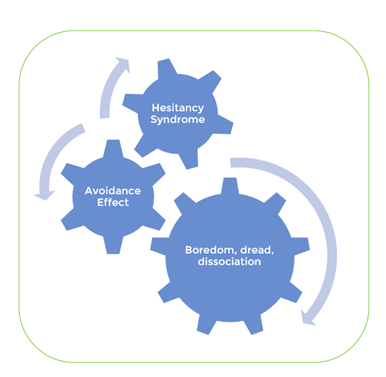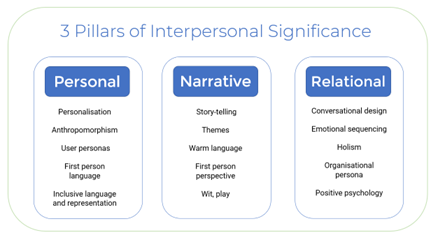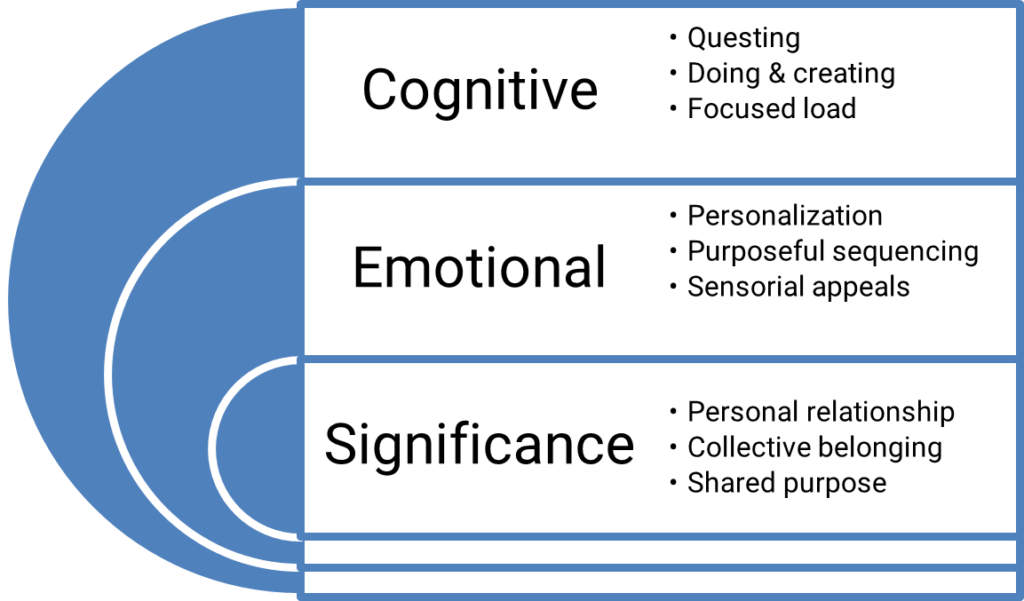Written by Heidi Staples, PhD.
[This article was originally published in the Autumn 2022 edition of the Communicator]
Digital overload can reduce productivity due to fatigue, as well as compromise the relationship between employer and employee. Any virtual employee training, particularly during the onboarding process, can be designed to offset the negative effects of escalating digitisation with a holistic relational approach.
Retention by Design: How people-first eLearning fosters employee loyalty
According to the World Economic Forum, between 2020 and 2021, “the share of paid jobs offering remote work had nearly doubled” (2020). Many of us cheer for remote work. This shift to the screen, however, is escalating the intensity of human/computer interaction and the chance of burnout. While we create rapidly developed eLearning to keep up with the current changes, we may need to take care, especially during
eLearning as Brain Training
Let’s call non-holistic virtual employee training brain training. Brain training assumes cold cognition theory, the theory that only “merely ‘adequate’ levels of selective attention and reasoning are required in order for learning to occur” (Westhuizen 2020). Such a reason-focused programme compartmentalises cognitive processes and severs brain and body.
The need for rapidly developed digital training can create a dependence on cold cognition theory: to get the training done quickly, you assume that merely adequate levels of attention and reasoning are enough. The content is plopped into a dreary box on the page. The images are dropped into a similarly predictable spot. Monotone icons merely repeat the learning content, offering no new information. The learner quickly grasps that the graphics are irrelevant bobbles to dismiss. Silence pervades, or the only audio is that of an obviously AI voice narrating a technical simulation. The senses are mostly ignored. As predictability sets in, boredom rises. As the body is ignored, a dissociative state with selective attention comes about. One former employer required hours of cold cognition compliance training annually. (Note the word “former.”)
Digital Learning with Pain Drains
However boring the presentation, the training is often essential. The necessary effort is not a problem. Learning does happen most effectively when there’s some struggle. The learner must strain the brain. Onboarding presents a unique problem. During onboarding, learners must process days of new people, procedures, and policies. The ceaseless cascade of new information can easily become overwhelming.
When the effort to process such an onslaught is fuelled mostly by the emotional resources of fear due to induction requirements to complete particular employee training modules and boredom from repeated poorly designed lessons, the pain drains any sustaining internal resources. Focus, curiosity, enthusiasm, and ultimately, perhaps, the employee’s attachment to their new role can be drained by non-holistic, cold cognition training, and with that goes the organisation’s optimised productivity.
eLearning and the Avoidance Sequence
Hours of merely functional training can start to seem like an initiation into a drudgery standing between us and a regular paycheck. In an induction, we do sit through several hours of, let’s be honest, mind-numbing training sessions.
However, the conventional, rapidly diminishing instructor-led training of yore offset dreary bureaucratic processes with enlivening social interaction.
In live employee training, we share the experience like good soldiers in the trenches with our colleagues. Through these live bonding experiences around the pain of tedium, we become a cohesive unit with shared memories. This sense of belonging is an important knock-down effect. However, the effect is lost or compromised when we automate training designed with cold cognition theory.
When we remove the social context, we remove the pleasure principle that helps motivate engagement, and these changes to the terms of the transaction may be made without apology or mitigation. Unaddressed negative emotion within the training that leads to boredom can turn to dread and even creeping despair. Starting a new position alone at a desk for days collaborating with a blank, humourless, nothing-but-the-facts machine is, as they say, some “How are ya?”
Let’s call what can happen next the Avoidance Sequence. I remember it well from my time with that former employer. In the Avoidance Sequence, new starters experience initial eagerness to do training, not only for its own sake but also, I think, out of a desire to connect with the employer. Once the learner realizes the training relies on cold cognition, the attention level dials down. As the design pattern becomes predictable—cognitive, technical, mechanical–the eagerness dissipates into boredom and dissociation.
Onboarding with the Hesitancy Syndrome
A non-holistic learning design doesn’t just lack pleasure – it requires a learner to dissociate from a desire for pleasure. When the dissociation and boredom become unrelenting, a dread of continued training may set in. When the dread is met with the machine’s indifference, it can lead to an undercurrent of despair and even, let’s go ahead and say it, a little resentment.
A subtle cascade of negative feelings can set the user on course to being conditioned to avoid training whenever possible, or they may avoid the experience only in an imagined fantastic scenario where boredom is not necessary, that is, in a role at a different organisation.
True, the most diligent learner will adopt the programme readily enough, and perhaps those who grin and bear the boredom are the best employees. But what does disregard for the subjective whole-person experience cost the relationship between employee and employer? Unlike machines, humans have subconscious and unconscious processes that, for better or worse, will be active in their onboarding. The unconscious feelings of detachment toward the employer that can result from an unsatisfying onboarding experience create what I’m calling the Hesitancy Syndrome, illustrated below:

Non-holistic training grounded in cold cognition communicates implicitly that a new starter’s feelings and needs for significance are not all that relevant to the organisation. It might imply that the only thing that matters is an employee’s ability to download and implement the necessary information. It could leave the employee feeling like the organisation only wants them for one thing. This sort of arrangement fails to maximize the new starter’s potential as a person with feelings. Engaging with an employee’s emotional reality could dramatically impact their productivity and retention.
Lean-in eLearning
The alternative to cold cognition theory is hot cognition theory. Hot cognition theory recognizes the “full extent to which emotional conditions, or ‘affects’, influence the capacity of working memory. As such, the affective system allows learners to make rapid conscious and subconscious judgements, which are central to the learning process” (Westhuizen, 2020). A learning experience that reaches beyond brain training into the centres of motivation and desire pays respect to the adult’s learning preference for self-direction, operating through subtle persuasion rather than blunt coercion.
Holistic relational eLearning relies on hot cognition theory in any design, even for rapid development, resulting in what I’ll call lean-in learning. The content’s placement may be patterned, but with enough variation to create surprise. Imagery illuminates or elaborates on textual content, providing valuable information and requiring attention. The learner immediately recognizes the visuals as strong content, designed to add value. Soundtracks and effects provide sonic interest, and voiceovers inspire a sense of connection. The senses are brought into the experience, yet with restraint to limit cognitive load. As interest rises, so too does the recognition that care has been taken to offset potential drudgery.
This is well-designed training. It engages emotions and the need for significance. It shows concern not only for the conveyance of critical technical information but also for the learner’s experience as a human being. When such training has been strategized to engage emotions through a holistic approach, there is even the potential for the learning to improve the relationship between the employer and the employee.
Digital Learning with Pain Gains
When we offset potential drudgery with relational relief, we can potentially free up employee energy. Now, they can transmute their yearning to be elsewhere into their learning of the material at hand. An implicit communication of relational significance imbues the near-constant learning required during onboarding with meaning.
We all want to feel supported, heard, and properly equipped at work. The 3 pillars of interpersonal significance (see below) provide guidance for creating implicitly courteous and considerate training materials for new starters.

Feeling a sense of natural reciprocity, employees may then be more willing and able to give their best to related challenges. Focus, curiosity, enthusiasm, and perhaps the employee’s attachment to their new role may be inspired by holistic relational online training. They may then sustain and boost the organisation’s productivity.
eLearning and the Engagement Sequence
Time spent in holistic relational online training can feel like an invitation into a considerate, supportive work culture. Employees can experience the contemporary, rapidly emergent machine-led learning of today as a well-strategized supportive employee benefit. In such an induction, we are invited to be onboarded through engaging, personalized modules that take care to relate to us as people. Employees feel recognised through subtle emotional appeals that acknowledge our need for significance. The subsequent sense of a connection can have a lasting impact on employee retention.
When we envision online training as a social environment, we are forced to consider what sort of persona we project and what experience we provide. Rhetorical decisions that create a sense of interpersonal significance help make training pleasurable, motivating, and engaging. Positive emotion can lead to appreciation, engagement, relief, and even loyalty. Launching into a new position while collaborating over several days with a considerate, supportive, and innovative organisational persona provides a warm welcome and primes a new employee for job satisfaction.
Onboarding with the Loyalty Effect
When content is designed carefully by professionals trained to use language strategically, online training will do more than transmit instructional material. Expert content strategy can transmit information implicitly, relaying company values and attitudes toward employees. By engaging the person on the other side of the machine, this strategic content can create what I call the Loyalty Effect.
The Loyalty Effect arises from holistic design choices. It happens when the user of digital content recognizes that care has been taken to engage them on a personal level. The experience may be mediated by a machine, but the exchange is between themselves and other people.
The following infographic shows the Loyalty Effect’s components:
eLearning Design with People in Mind
Employees want to know they are more than merely resources from which the energy for labour is extracted. Each of us may be in an increasingly intimate symbiotic relationship with machines, but for our part, we remain creatures with flesh and blood, and feelings.
Holistic relational eLearning calls out to the humanity of employees. It seems obvious that employers who are best at engaging the shared humanity of their employees are most likely to be rewarded with that humanity, with for example, gratitude, the extra mile, and loyalty from employees.
During this era of escalating employee skills training, digitisation, and subsequent digital fatigue, and at a time when organisations scramble to retain talent, connecting across the wires with a new starter’s shared humanity will set employers apart.
Glossary
- Avoidance Sequence: A potential sequence of negative emotional experiences in training founded on cold cognition theory, resulting in an unconscious avoidance of further training.
- Brain training: Training that appeals only to cognition, producing an implicit logic of mutual exploitation.
- Cold cognition theory: Learning theory that asserts that limited, selective attention and reasoning are enough.
- Engagement Sequence: A proposed subconscious cumulative impact of relational digital training that inspires new employees to engage with the training.
- Hesitancy Syndrome: A proposed subconscious cumulative impact of nonrelational digital training that leaves an employee hesitant about long-term loyalty.
- Holistic relational eLearning: eLearning that communicates an approachable, supportive organisational persona through holistic design elements.
- Hot cognition theory: Learning theory that asserts embodied, integrated, holistic appeals, produces the most effective learning.
- Onboarding: The process of integrating a new employee into an organization
- Organisational persona: Semi-fictitious representation of organisation that helps implicitly communicate values and attitudes to trainees.
- Lean-in eLearning: eLearning experiences that generate a desire for further learning, producing a positive feedback loop or circular training ecology.
- Loyalty Effect: A proposed subconscious cumulative impact of relational digital training that inspires an employee to consider loyalty toward the organisation.
- Pain drains: Learning experiences with unaddressed emotional demands, decreasing employee satisfaction.
- Pain gains: Learning experiences requiring necessary cognitive effort, with emotional engagement that offsets emotional demands.
References
- Westhuizen, Millie Van Der (2020), Edge Education blog, ‘Emotional design in eLearning’ (online) available at https://edgeeducation.com/emotional-design-in-elearning/
- Whitfield, Honora (2022), Five Moments of Need blog, ‘Leadership Matters | Challenges and Opportunities of Leading Learning’ (online) available at https://blog.5momentsofneed.com/2022/03/leadership-matters-challenges-and.html
- World Economic Forum, The Future of Jobs Report 2020 (online) available at https://www.weforum.org/reports/the-future-of-jobs-report-2020












